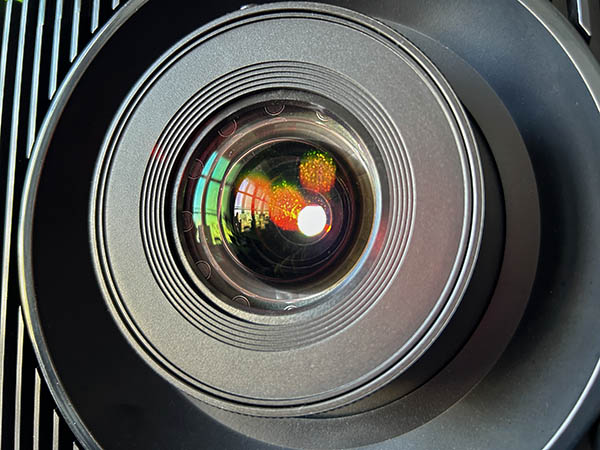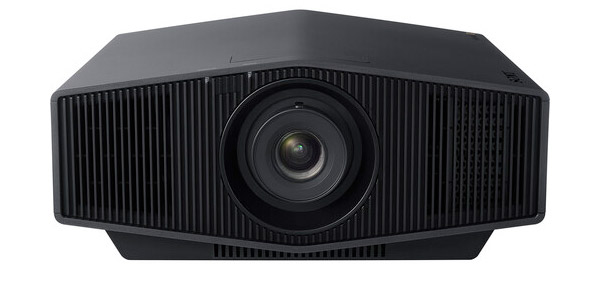Sony XW5000ES 4K HDR Laser Projector Review Page 2
If you are already familiar with Sony's SXRD projection technology, you won't be surprised by how this projector performs. The main difference to note is that the projector now uses a laser light source instead of a bulb. Additionally, the new imagers are native UHD, with a resolution of 2,160 x 3,840 pixels. This is different from older models, which had a resolution of DCI 4K, or 4,096 x 2,160 pixels. Finally, the projector's processor is more powerful than previous models.
According to Sony, the projector is slightly smaller than its immediate predecessor due to a reduction in the dimensions of the SXRD imager chips and the domino effect that has on the rest of the components, including the lens. Like Sony's previous entry-level 4K home theater projectors, the lens is not as high-quality as those used in more expensive models. However, the lens is sharp enough to produce clear images from a normal viewing distance. The main difference with the XW5000ES versus older models like the 325ES is that the lens is now manual, which can make initial installation more challenging (focusing becomes a two person job). However, since installation is typically a one-time process, sacrificing powered zoom, shift, and focus is perhaps a worthwhile trade-off for the benefits of a laser light source at this price point.
The picture modes offered by the Sony XW5000ES projector are similar to those of previous models. Modes like Photo, TV, and Bright TV are not accurate and do not provide any advantage in terms of brightness, saturation, or contrast when compared to the more precise modes, such as Cinema Film 1, Cinema Film 2, Reference, Game, Bright Cinema, and IMAX Enhanced (for use with IMAX Enhanced content).
When it comes to light output, some projectors advertise an ANSI lumen specification that is not realistic. After calibration or optimizing for movie playback, the actual brightness can be significantly lower than the advertised rating. However, this is not the case with the Sony XW5000ES projector. In the Bright Cinema mode, the projector's ANSI rating is accurate. In my tests, I measured 1,970 lumens for both SDR and HDR content. And you lose little even after calibration or optimization.

Using a light meter, I measured the peak light output of each picture mode and found Game offers 1,690 lumens. The home theater-friendly modes are all very close in output. Cinema Film 1 offers 1,780 lumens, Cinema Film 2 is good for 1,680 lumens, and Reference puts out 1,690 lumens. What's remarkable is that all these modes are significantly brighter than the 1,500 ANSI lumen rated peak brightness of the VW325ES.
If you don't get a pro calibration, I recommend using the more accurate modes for the best picture quality, but what works best for any given installation will ultimately depend on the combination of room, screen, and projector. What matters is Sony supplies the presets and tools needed to optimize the projector.
There are a couple areas where I had hoped to see some progress in performance versus prior generations, namely color gamut and native contrast, but this was not the case. Most picture modes covered around 88% of the DCI/P3 gamut used for HDR mastering, as well as 100% of the Rec.709 gamut used for SDR content. The highest measured native contrast I could coax out of it was roughly 6,000:1.
After the initial setup, I noticed significant chromatic aberration in the image. My initial assumption was that the lens was the culprit. However, I soon realized that the aberration was not evenly distributed, which led me to believe that the three imaging chips may have become misaligned during shipping. Fortunately, the solution was a simple adjustment in the Panel Alignment menu that took only a few seconds. After making the adjustment, the image was free of visible aberration and was reasonably sharp, although not as sharp as Sony's more expensive models that feature the Advanced Crisp Focus lens.

In a typical review, this is the part where the reviewer delves into the intricacies of color accuracy and describes how it affects the image quality of specific scenes. However, while I was working on this review, I attended a projector shootout hosted by Projector Reviews and Value Electronics. The shootout included the Sony XW5000ES, along with the more affordable Epson LS12000 ($5,000), LG AU810UP ($4,000), and the pricier, bulb-based JVC DLA-NP5 ($7,000). This experience allowed me to evaluate the XW5000ES in comparison with other projectors and helped me form a more informed opinion of its value proposition in ways that the standalone review evaluation could not.
After comparing the Sony, Epson, LG, and JVC, I concluded that the XW5000ES was the real winner. Granted, the JVC edged out the Sony in the scoring. So why is the XW5000ES the winner in my book? Because the XW5000ES performs almost identically to the JVC but is less expensive and features a laser light source. In comparison, the Epson was visibly inferior in terms of performance, and the LG was at least two steps behind.
Let's cut to the chase: The JVC DLA-NP5 has an advantage over the Sony when it comes to HDR and tone mapping. JVC's Frame Adapt dynamic HDR technology is known to be highly effective, and I saw firsthand, side-by-side versus the Sony, how it produced a better image in certain difficult dark scenes. However, these scenes are relatively rare, and this issue only applies to HDR content, not SDR. Overall, the Sony and JVC perform similarly, often producing equally good images with a given scene. In my opinion, the decision between the two should be based on the price and the laser light source.
The Sony XW5000ES projector is particularly impressive when it comes to gaming. It now supports 1080p at 120 Hz, and has Reality Creation upscaling capabilities. When using either my PS5 or Xbox Series X, the 120 Hz/1080p output looks almost as sharp as 4K, but the frame rate is incredibly smooth, and the input lag is in the same league as gaming projectors and high-end TVs. I measured the input lag at only 11 milliseconds in the middle of the screen. In games that support 120 FPS, such as Dirt 5 or Tony Hawk's Pro Skater 1 + 2, gameplay feels incredibly responsive, and I definitely gain a competitive advantage from the low lag.
Many console games do not support 120 FPS, while others don't need the faster frame rates and look better in native 4K. In these cases, the input lag is still an impressive 19 milliseconds. Regardless of the frame rate or resolution, the large screen experience is truly immersive. By simply dimming the lights, the experience of feeling almost like you are inside the game is unforgettable, and it's definitely worth experiencing on a big screen rather than just watching it on a small display.
Forza Horizon 5 for the Xbox Series X and Gran Turismo 7 for the PlayStation 5 are two of the best-looking driving games available. Gran Turismo 7, in particular, looks incredibly realistic when you choose to prioritize ray tracing over frame rates. It is so authentic to real life, a casual observer might mistake it for live footage at first. If you are a fan of racing simulators, the combination of the PS5 and the XW5000ES projector offers an unbeatable sense of being at the wheel of a high performance automobile.

The XW5000ES projector's motion handling is exceptional. I used the Spears & Munsell UHD Benchmark stock ticker test clip, and with the MotionFlow setting on high, it completely smoothed out the motion. While this setting is not suitable for movies, as it can make them look unnatural, it can improve the perceived clarity of sports content, reality television, and other types of video. For movies, the True Cinema setting is the best choice as it preserves the natural motion cadence of film and helps reduce judder without changing the feel.
The most amazing thing I saw on this projector was 4K baseball. It was a bittersweet year for Philly sports fans, we managed to lose three major championships! But just seeing the World Series in 4K HDR on a 140-inch screen had a strong effect on me. I had come to dismiss baseball as boring, but when you bring in the sights and sounds of the game with the higher fidelity of 4K and surround-sound, what seems boring on a small screen becomes visceral. You see the grimaces and the sweat, not to mention the ball itself, with a movie-like crystal clarity that is almost hyperreal.
Conclusion
Dedicated standard-throw home theater projectors are becoming an endangered species, so it's nice to see Sony offer a comprehensive refresh to its lineup, and in particular to see it phase out bulb-based projectors once and for all. Thanks to this change, among Sony's three consumer 4K projectors, the VPL-XW5000ES easily provides the best value for the price.
The move to a laser-phosphor light source is what makes the VPL-XW5000ES such a screaming good deal. But it's only a bargain if you specifically seek what it offers: A cinematic projected 4K picture that flatters film, along with robust gaming support. It does its best work in darkened rooms, which can be limiting. And now, it has to compete with a burgeoning ultra-short-throw (UST) category, as well as a growing selection of 98-inch TVs.
Serving as an all-around display is a tough task with only 2,000 lumens on tap, but if you pair this Sony with a good screen and give it a dark room to work with, the picture it puts out is arguably closer to the creative intent of a Hollywood director than any UST, and at screen sizes that TVs still cannot touch.
The bottom line is the XW5000ES may be expensive compared to a TV or even a UST, but you'll wind up spending a lot more to get a better performing native 4K projector with a laser light source. So while it is lamentable that Sony's choice of lens is somewhat limited in functionality and performance—it is the weakest link and holds it back from fully realizing the potential of the SXRD imagers and X1 Ultimate for projector processor—Sony still deserves credit.
The combination of the laser light source and the power of the X1 Ultimate for Projector processor gives the VPL-XW5000ES projector an edge over its competitors in terms of performance and longevity. The quality of the projected image it produces is unmatched for the price among projectors of its type, making it a top choice for 2023.




























































